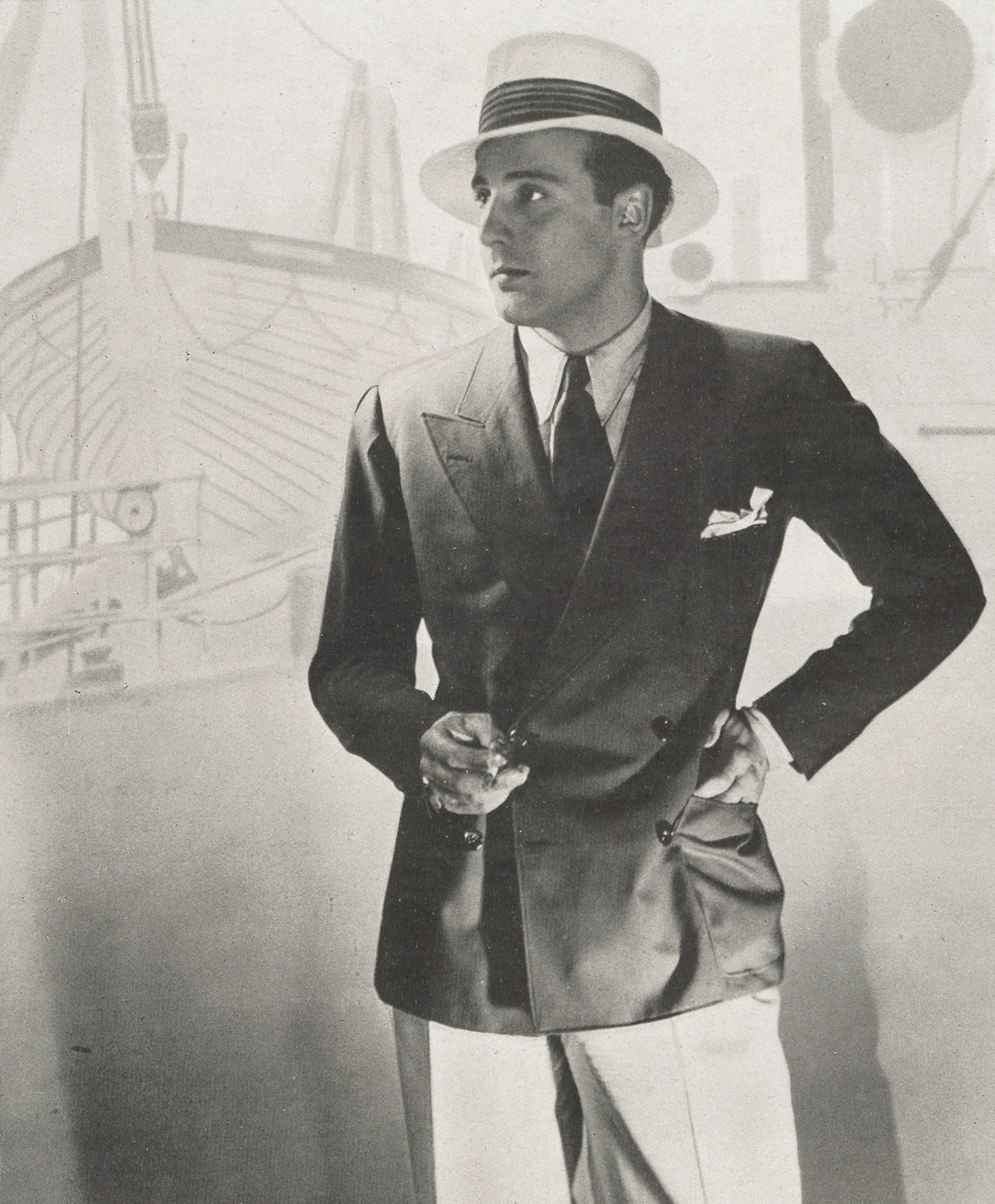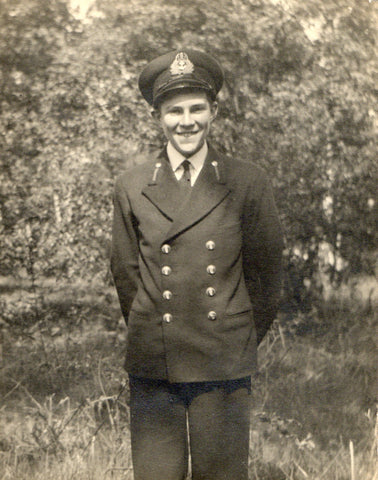The Double-Breasted Blazer

In the world of menswear, the name ‘blazer’ is attached to two quite distinctly different garments: the navy blue jacket that adds a touch of formality to a casual outfit; and the striped or brightly coloured jacket worn at sporting events such as the rowing regatta. However, it is the classic navy blue double breasted jacket that we are considering here.

Both garments share their sporting origins on the water. The sports blazer was the garment of choice for rowing clubs, with its bright stripes or vivid solid colours supposedly being described as ‘ablaze with colour’. A close relative of the ever-popular ‘Pea Coat’, the heavy wool short coat favoured by mariners which was designed specifically for foul weather, the navy blue double-breasted jacket has its origins in the uniforms of the Royal Navy and Britain’s merchant fleet, which then spread to navies worldwide, before being adopted by yachtsmen and weekend sailors. In this version of the story, the short double-breasted jacket was first adopted by the crew of HMS Blazer, thus giving the garment its name.
Whichever various versions of these stories are true, the navy blue double-breasted blazer was a garment that cemented its popularity in the early 20th Century. Based on the doeskin or serge ‘reefer jacket’ worn by Royal Navy officers, the jacket originally had two lines of four gold buttons, a high button-stance and peaked lapels. The high closure and deep wrap was perfect to keeping the wind out as officers stood on the ship’s bridge.


With the UK’s rich maritime heritage it was natural that the style would spread beyond the wardrobes of professional sailors. Understanding the practical nature of the double-breasted jacket, retired or off duty sailors took to wearing the jacket when taking to the waters in their yachts. Yachting clubs adopted the look and civilian yachtsmen copied the style. Club badges were soon added and a distinctive look began to emerge. As the mark of a man wealthy enough to own a boat, the club blazer acquired an elitist image, yet this was transcended as the look became increasingly popular and the style was adopted by men who realised it simply looked good.


As leisure time increased in the early 20th Century, in particular in the aftermath of the First World War, the influence of more relaxed fashions became important, challenging the dominance of the suit. Just as equestrian, golfing or cycling styles were filtered into mainstream fashion, soon the nautical look of the blue blazer and cream or white flannel trousers, often combined with white shoes and perhaps a peaked nautical cap, became a fashionable look. The fashion spread to landlubbers as the look became popular for those whose knowledge of the ways of the seafarer went no further than strolling along the promenade or taking a young lady out in a rowing boat, hoping to spend a few intimate minutes in the secluded shelter of the branches of a riverbank willow tree.


By the 1920s it was part of the standard outfit for thousands of holidaymakers from Brighton to Biarritz, as men wore their blazers with flannels and open sports shirts whose soft collars were increasingly worn outside the collar of the blazer. The fashion also spread to sports clubs and, with the blazer combining perfectly with white or cream trousers, polo shirts and shoes, becoming a firm favourite of tennis clubs, bowls clubs, and other sporting establishments. By the late 1920s it was a look that had spread worldwide.

To distinguish between the uniform look of the Royal Navy and the casual fashion favoured by weekend sailors, civilian blazers often had fewer buttons and, in time, the blazer began to follow the dictates of fashion, with its lapels expanding and contracting as determined by the styles of the times: Blazers were worn long in the early 1920s but were worn in the short ‘bum freezer’ style in the late 1950s and early 1960s. Then, by the late 1960s, some fashionable young men returned to the high-fastening styles of the original nautical blazers.

As the blazer became a leisure item, rather than just a practical seafaring coat, the choice of fabrics changed. The heavy serge and doeskin that was needed to keep out the elements on the high seas was replaced by lighter woollen cloths, with melton and worsted wools – in particular barathea - becoming popular choices. Barathea was perhaps the most popular blazer fabric as it combined the comfort of its soft feel with the formality of its look, making the blazer the ultimate ‘smart casual’ garment. For warmer climes, open-weave wool twist cloth, which allowed the wearer to retain both their cool and their formality, was also popular. This was sold under a number of names, with the name of one particular cloth that was woven in Huddersfield, ‘Fresco’, becoming almost generic and applied to other brands of the cloth.

After many years as the casual garment of choice for both sportsmen and men of leisure, in the post-war period the double-breasted blazer became an increasingly formal item, less associated with stylish young men and more associated members of golf clubs. In the UK many associations for military veteran adopted blazers, complete with medals and a regimental badge, along with grey trousers and highly-polished black shoes in what amounted to a ‘uniform’, allowing them a sense of identity when attending official parades and memorials.
The choice of some schools to include a double-breasted blue blazer, complete with the school badge, as part of their uniform helped to undermine the garment’s reputation, with ex-pupils gleefully casting off their blazers as soon as their schooldays were over. It was an era when the ‘new boy’ in an office could easily be spotted as the teenager wearing a blazer with loose stitches and a faded patch showing where his school badge had once held pride of place.


By the 1960s and 1970s you were more likely to see a blazer, often with the badge of a regimental association, worn by the landlord of your local pub than worn by a stylish young man. The passing of the years saw blazers acquire an ill-deserved reputation as a jacket simply for the would-be elite, favoured by company-car driving golf club presidents or retired army colonels, often depicted as sitting in their club chairs firing off disgruntled letters of complaint to the Daily Telegraph. In TV and cinema the blazer with its club crest was also the outfit of choice to depict crooked second-hand car dealers or lovable rogues, of the type played by Terry-Thomas. The blazer had the unique ability to say ‘respectable’ and ‘dodgy’ at the same time.

Yet, despite this once unfashionable image, well-dressed men around the world continued to understand how the blazer could be worn with style. Think of one of the late-20th Century’s great style icons, James Bond, both dressed in his Royal Navy uniform, or dressed more casually in a blazer, especially in Roger Moore’s depiction of the character. Pierce Brosnan also appeared in a blazer in Goldeneye, wearing it in a less traditional style; unbuttoned with an open-neck blue shirt underneath.


The Italian industrialist Gianni Agnelli, who has been widely acknowledged as one the most stylish dressers of the 20th Century, was a fan of the blazer. His influence was key in the garment’s enduring popularity in Italy and its continued appearance among the eager crowds seen at the Italian menswear trade show, Pitti Uomo. Ralph Lauren is another fan, who helped popularise the wearing of a blazer with jeans and whose company made sure the double-breasted blazer reasserted itself as a casual garment for both men and women.

The beauty of the navy blue blazer is its versatility: worn with white or cream trousers it retains its original nautical look, just perfect for cocktails in some Riviera resort; worn with rolled up trousers and plimsolls, the blazer can still be worn at the helm of a yacht; mix the blazer with tan chinos and button down shirt for a casual look, to give off that Kennedys vibe; wear it with grey flannels and the blazer is perfect for the more formal events in your summer calendar. The more adventurous might even choose to combine their blazer with tailored shorts.
The blazer can be combined with a range of shirts and accessories: on those brisk summer mornings by the seaside, a loosely knotted silk scarf is the perfect accompaniment to a blazer. For a casual look, mix it with a polo shirt and silk neckerchief, or even a blue and white hooped t-shirt to retain that maritime look. For winter, a generously cut blazer can be worn over a heavy cream submariner sweater, for a look originally popularised by sailors.


Worn with a shirt and tie, or open necked with your soft collar gently flapping in the summer breeze, the navy blue double-breasted blazer has a distinct charm that is acknowledged by stylish men worldwide.